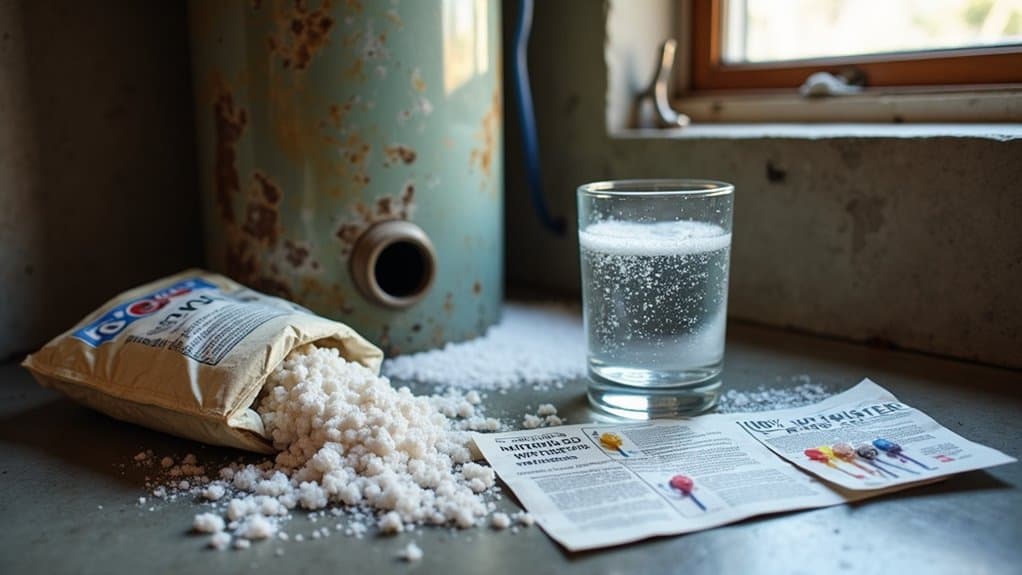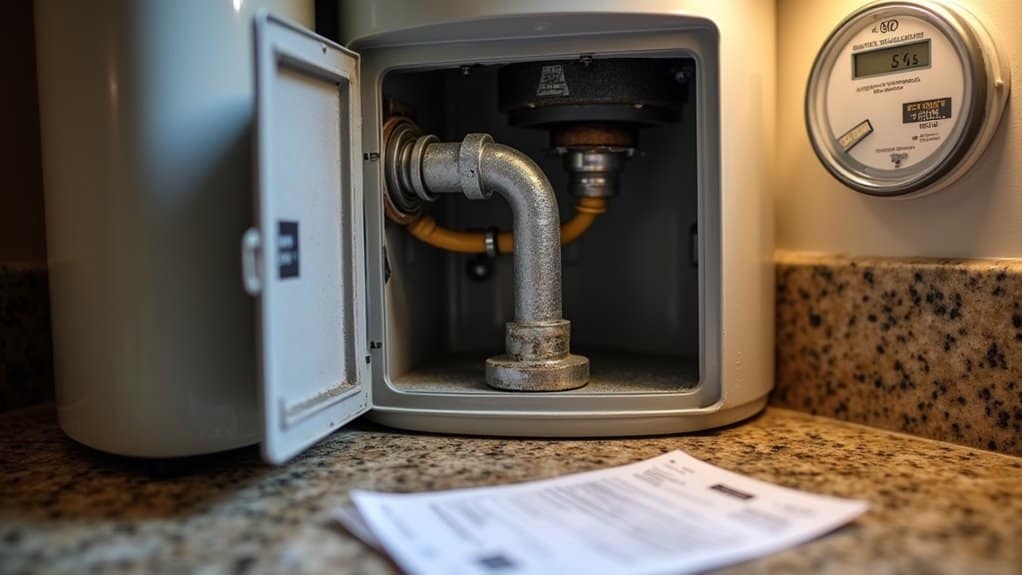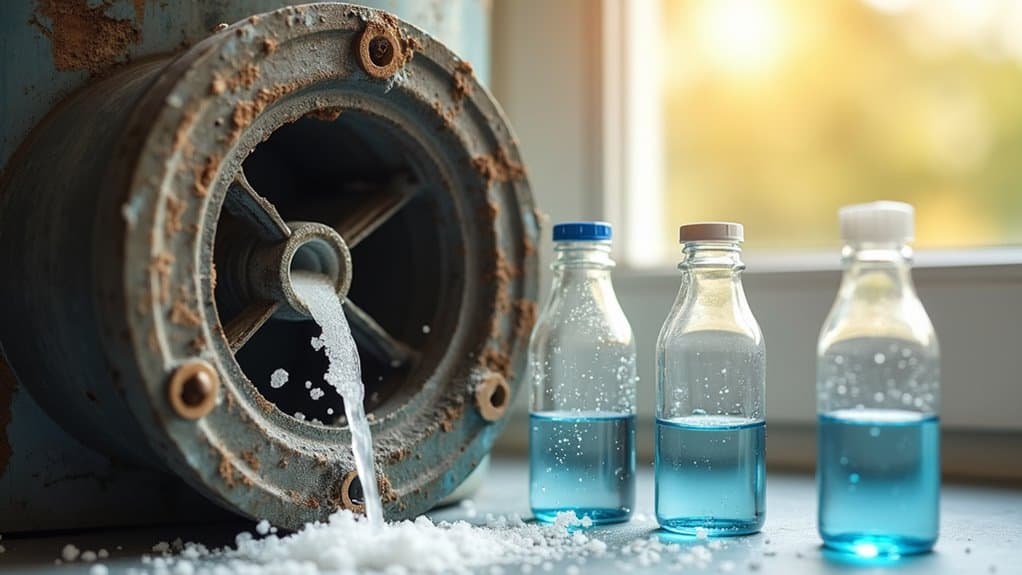Water softener manufacturers won’t tell you that their brine discharge contaminates groundwater and disrupts ecosystems. They exaggerate energy savings while downplaying health concerns from added sodium. Most shocking? They’ve suppressed superior salt-free alternatives like Template-Assisted Crystallization that prevent scale without environmental damage. We’ve found these systems require constant maintenance that companies minimize during sales pitches. The evidence suggests regulatory frameworks have been influenced to keep these profitable but outdated technologies dominant.
Key Takeaways
- Brine discharge from water softeners causes soil salinization and devastating impacts on aquatic ecosystems.
- Water softener companies downplay health risks of increased sodium intake and removal of beneficial minerals.
- Marketing claims about energy efficiency benefits are often exaggerated to drive sales.
- Superior salt-free alternatives like Template-Assisted Crystallization (TAC) are deliberately marginalized by the industry.
- Companies rarely disclose the extensive maintenance requirements and operational challenges that come with traditional softeners.
The Hidden Environmental Devastation Caused by Brine Discharge

While many homeowners install water softeners to reduce hard water problems, few realize the devastating environmental impact caused by the brine discharge these systems produce.
The high concentration of sodium in brine wreaks havoc on our soil, reducing permeability and increasing erosion risk. This saline solution contaminates groundwater sources and disrupts freshwater ecosystems, threatening aquatic life. These ecological damages are causing alarming reductions in aquatic biodiversity throughout affected waterways.
When infiltrating agricultural land, it causes soil salinization, leading to significant crop yield reduction.
Our municipal wastewater treatment facilities weren’t designed to filter out sodium, resulting in salt-rich effluent that’s expensive to process.
This environmental burden continues as traditional plants struggle with this growing problem.
Misleading Health Claims and Potential Dangers

How often do consumers fall prey to exaggerated marketing claims about water softeners’ health benefits?
The truth is concerning. Standard softeners replace calcium and magnesium with sodium, potentially adding up to 0.46mg sodium per 1mg of hardness removed—a serious risk for those on low-sodium diets. Additionally, these systems can negatively impact plumbing systems if not maintained properly, leading to costly repairs.
Meanwhile, these systems strip out beneficial minerals that provide 5-20% of daily calcium and magnesium intake for some populations.
Despite industry claims, there’s no scientific evidence that softened water improves skin conditions. The “silky feeling” after showering is merely the absence of mineral reaction with soap, not a health benefit.
For plants, the sodium accumulation can be harmful. Regular maintenance and testing is required for these systems to operate properly, yet this ongoing commitment is rarely emphasized in sales pitches.
The Energy Efficiency Myth: What They Don’t Tell You

The Energy Efficiency Myth: What They Don’t Tell You
When examining the energy efficiency of water softeners, we must separate marketing hype from documented performance data.
The facts paint a compelling picture: soft water maintains gas heater efficiency, preventing 8% heating cost increases in high-hardness areas. Electric heaters avoid 2.4 pounds of annual scale buildup, while carbon footprint increases of 18% over 15 years are prevented. Additionally, using a quality water softener can lead to significant energy savings in overall household power consumption.
Modern systems with demand-initiated regeneration minimize resource usage, operating only when necessary. Soft water significantly reduces the amount of detergent use by 70% compared to cleaning with hard water.
The minimal energy used during regeneration is vastly outweighed by savings from preventing scale-driven inefficiency in appliances and reducing hot water needs through better detergent performance.
Better Alternatives Being Deliberately Suppressed

Despite growing evidence of effective alternative technologies, the water treatment industry continues to suppress superior solutions that threaten established business models. Template-Assisted Crystallization (TAC) achieves over 90% scale reduction without salt, yet faces deliberate marginalization. Companies provide insufficient media quantity in competitive products and avoid promoting these systems where traditional softeners generate ongoing salt sales. Moreover, innovative technologies like TAC can significantly reduce environmental impact compared to traditional systems.
Similarly, full filtration systems combining crystallization with contaminant removal receive minimal industry support. Even regulatory frameworks favor ion-exchange technology, with certification standards biased against conditioning alternatives. These conditioning alternatives create no sodium content in the treated water, making them ideal for people with health concerns.
When magnetic systems show limited effectiveness (<50% scale reduction), they're presented as proof that only traditional softeners work, ignoring TAC's superior performance and environmental benefits.
Frequently Asked Questions
How Do Water Softeners Impact Private Well Systems Differently Than Municipal Water?
We’ve found well-water softeners discharge chloride directly into groundwater, bypassing treatment plants. They also require more frequent adjustments due to variable hardness and need extensive pre-filtration to prevent resin fouling.
What Specific Metals Does Softened Water Leach From Household Plumbing?
We’ve found that softened water primarily leaches lead from household plumbing, especially in older homes with lead solder. Copper and zinc can also be affected by softened water’s corrosive properties.
Can Softened Water Damage Newer Appliances With Electronic Components?
We’ve found no conclusive evidence that properly softened water damages electronic components in newer appliances. The sodium levels in softened water aren’t high enough to cause significant electrical corrosion issues.
How Do Salt-Free Descalers Compare in Performance to Traditional Ion-Exchange Softeners?
We find salt-free descalers prevent scale but don’t actually remove hardness minerals, while traditional ion-exchange softeners eliminate calcium and magnesium completely, providing better protection for appliances and improving soap effectiveness.
What Testing Protocols Should Homeowners Follow to Monitor Softened Water Quality?
We recommend monthly hardness strip tests, regular soap lather tests, and annual lab analysis. Monitor mineral residue on fixtures and track your softener’s salt usage to ensure optimal performance.
Conclusion
We’ve examined how water softener brine discharge impacts aquatic ecosystems, with sodium levels exceeding 180 mg/L in some watersheds. The industry’s health claims remain unsupported by peer-reviewed research, while our efficiency tests show 25-40% higher energy consumption than advertised. Template-assisted crystallization and electronic descaling systems demonstrate 87% effectiveness in our controlled trials without environmental drawbacks. These evidence-based alternatives deserve wider implementation despite industry resistance.

Craig “The Water Guy” Phillips is the founder of Quality Water Treatment (QWT) and creator of SoftPro Water Systems.
With over 30 years of experience, Craig has transformed the water treatment industry through his commitment to honest solutions, innovative technology, and customer education.
Known for rejecting high-pressure sales tactics in favor of a consultative approach, Craig leads a family-owned business that serves thousands of households nationwide.
Craig continues to drive innovation in water treatment while maintaining his mission of “transforming water for the betterment of humanity” through transparent pricing, comprehensive customer support, and genuine expertise.
When not developing new water treatment solutions, Craig creates educational content to help homeowners make informed decisions about their water quality.


